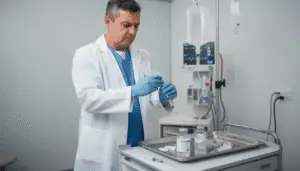Looking for IV therapy Encino? Learn about available services, benefits, potential risks, and what to expect during a session, helping you decide if it fits your needs for hydration, nutrients, or medication.
Key Takeaways
IV therapy in Encino provides rapid hydration, nutrient delivery, and medication administration directly into the bloodstream, ensuring immediate effects and better absorption.
Patients can benefit from a customized approach to IV therapy, which includes various fluids and nutrient therapies tailored to individual health needs, enhancing overall wellness and energy levels.
Potential risks of IV therapy, such as infiltration, phlebitis, and infections, highlight the importance of administration by trained professionals in a sterile environment to ensure patient safety.
Introduction to IV Therapy
IV therapy, also known as intravenous therapy, is a medical treatment that involves administering fluids, medications, and nutrients directly into a person’s vein. This method is particularly effective for treating various medical conditions, including severe dehydration, fluid overload, and electrolyte imbalances. By delivering medications and essential fluids like normal saline and lactated Ringer’s solution directly into the bloodstream, IV therapy ensures rapid and efficient absorption, helping to restore normal fluid balance and promote overall health.
The primary goal of IV therapy is to provide the body with the necessary fluids and medications to address specific health issues. For instance, in cases of severe dehydration, IV therapy can quickly replenish lost fluids, while in situations of fluid overload, it can help manage and balance fluid levels. Additionally, IV therapy is used to deliver medications such as antibiotics and pain relievers, ensuring they reach the bloodstream promptly and effectively.
Overall, IV therapy is a versatile and effective treatment option for a wide range of medical conditions, offering immediate benefits by bypassing the digestive system and delivering essential nutrients and medications directly into the circulatory system.
IV Therapy Services in Encino

IV therapy involves administering fluids directly into a vein for hydration, medication delivery, and nutrient supplementation. This method ensures that essential fluids and medications enter the circulatory system swiftly and effectively. In Encino, IV therapy services are widely available, accommodating both medical and wellness needs.
The administration process uses a flexible plastic tubing called an IV administration set. This set includes an IV bag, a primary bag, a secondary bag, IV tubing, primary tubing, and a cannula for intravenous access. The most common method for establishing this access port is the peripheral cannula, typically placed in the arm or wrist. This ensures that the IV fluids are delivered directly into the bloodstream for immediate effect. For pediatric patients, an arm board is often used to secure the IV site and prevent tampering.
In Encino, the IV therapy procedure starts with establishing an intravenous access site, usually by inserting a needle into a vein. The type of IV fluids and medications administered varies depending on the treatment.
Encino offers a range of IV therapy options, from hydration therapies to intravenous vitamin treatments, catering to diverse health needs. Whether recovering from an illness or seeking a wellness boost, IV therapy can be a valuable addition to your health regimen. Secondary tubing is often used to administer additional medications, such as antibiotics, alongside the primary IV solution.
Benefits of IV Therapy

Delivering medications and fluids directly into the circulatory system, IV therapy ensures immediate and effective results, especially for quick relief from dehydration or nutrient deficiencies. When medication enters the bloodstream via IV therapy, it acts rapidly, providing swift relief and effective treatment. Encino clients can receive personalized IV treatments tailored to their specific health needs, whether to deliver medications for recovery, energy boosts, or hydration.
IV therapy stands out for its ability to provide a wellness boost by replenishing essential nutrients and fluids directly into the bloodstream, bypassing the digestive system for better absorption and faster results. This is particularly beneficial for those with digestive issues, allowing them to receive necessary nutrients without complications. Additionally, IV therapy allows for the administration of more fluids quickly compared to oral intake, which is crucial for immediate hydration needs.
IV vitamin therapy is increasingly popular for supporting the immune system and enhancing overall wellness. Delivering vitamins and minerals directly into the bloodstream can improve energy levels, support immune function, and promote overall well-being.
IV therapy can be customized with specific nutrients and iv medications based on individual health assessments, ensuring each systematic review of treatment and other treatments meet the patient’s unique needs, including any additional medication. Patients often feel more energized and refreshed after a session, ready to take on their day with renewed vigor.
Including IV therapy in your health regimen can offer numerous benefits, such as improved hydration, better nutrient absorption, and enhanced energy and wellness. Whether treating a specific condition or improving overall well-being, IV therapy presents a versatile and effective solution.
Types of IV Fluids and Therapies
Intravenous therapy delivers fluids and nutrients directly into the bloodstream for immediate and efficient absorption. Several types of IV fluids and therapies are available, each designed to address specific health needs and conditions. Understanding these options can help you choose the right treatment.
Normal saline is an isotonic solution commonly used for hydration and addressing medical conditions like hemorrhage or diabetic ketoacidosis. It provides a balanced fluid composition that closely matches the body’s natural fluids, making it a versatile and widely used IV solution.
For patients with mild dehydration or sodium depletion, half normal saline, a hypotonic solution, is often recommended. This solution helps rehydrate the body while addressing specific electrolyte levels and electrolyte imbalances.
Lactated Ringer’s solution, on the other hand, closely resembles body plasma and is effective for restoring electrolytes and pH balance, particularly after burns or significant fluid loss.
Certain IV fluids, like colloids, remain in the blood vessels due to their larger molecular size, making them effective for maintaining blood volume and pressure in various emergency and therapeutic scenarios.
Dextrose solutions provide a quick source of energy and are often combined with other IV solutions to enhance hydration and restore blood sugar levels. These solutions are particularly beneficial for patients needing an immediate energy boost or those with low blood sugar levels.
Additionally, specialized IV vitamin therapy can deliver essential nutrients directly into the bloodstream, bypassing the digestive process and ensuring better nutrient absorption and hydration.
With a variety of IV fluids and therapies available, patients can receive treatments tailored to their specific health needs, whether for hydration, energy, or nutrient supplementation. This versatility makes IV therapy a valuable tool in both medical and wellness settings.
Parenteral nutrition is another critical method for delivering essential nutrients directly through an intravenous line for individuals who cannot obtain them through conventional eating and digestion. It can be categorized into total parenteral nutrition (TPN), which provides all nutrition needs, and partial parenteral nutrition, which supplements dietary intake. This approach is vital for patients with severe digestive issues or those recovering from major surgeries.
Methods and Equipment
IV therapy requires specialized equipment to ensure the safe and effective delivery of fluids and medications. The primary components include IV lines, IV bags, and infusion pumps. The IV line, which is inserted into a person’s vein, usually in the arm, serves as the conduit for the IV fluid or medication. This line is connected to an IV bag that contains the fluid or medication to be administered.
The infusion pump plays a crucial role in regulating the flow rate of the fluid, ensuring that the patient receives the correct amount of medication or hydration over a specified period. There are different types of IV access methods, including peripheral IV lines, central lines, and peripherally inserted central catheters (PICCs). Each method is chosen based on the patient’s specific needs and the type of treatment required.
Medical professionals use various techniques to achieve venous and vascular access, ensuring the IV line is properly placed. This process involves careful insertion of the IV line to minimize discomfort and ensure effective delivery of the IV therapy. The use of advanced equipment and techniques by trained medical professionals ensures that IV therapy is administered safely and effectively, providing patients with the necessary treatment for their medical conditions.
Common Uses for IV Therapy

IV therapy is widely used to manage fluid loss caused by severe dehydration, ensuring rapid recovery and rehydration through iv rehydration. This is particularly important for critically ill patients who need immediate intervention to stabilize their condition. By delivering fluids directly into the bloodstream, IV therapy ensures that the fluid rate is maintained, allowing the body to be receiving iv fluids quickly and efficiently, while also preventing fluid overload. IV therapy is also crucial for blood transfusions in cases of severe anemia or trauma, providing essential support in critical medical situations.
Aside from rehydration, IV therapy is also beneficial for those with digestive problems who struggle to absorb nutrients effectively. By bypassing the digestive system, IV therapy allows for better nutrient absorption, providing essential vitamins and minerals directly to the cells. This can significantly boost energy levels and overall wellness, making it a popular choice for those seeking to improve their health. In emergency situations, IV push is used for the rapid administration of medications, ensuring timely and effective treatment.
In wellness settings, IV therapy is commonly used to support the immune system and enhance overall well-being. By delivering necessary nutrients directly to the cells, IV therapy can help strengthen the immune system, improve energy levels, and promote better health. This makes it an attractive option for individuals looking to maintain their health and prevent illnesses.
Whether you’re dealing with dehydration, nutrient deficiencies, or simply looking to enhance your wellness, IV therapy offers a versatile and effective solution. Its ability to deliver fluids, nutrients, and medications directly into the bloodstream makes it a valuable tool in both medical and wellness settings.
IV Solution Administration
IV solution administration involves the precise delivery of fluids and medications through an IV line. This process can be carried out through a primary infusion, which is a continuous flow of fluid, or a secondary infusion, which involves intermittent delivery of medication. The IV pole is used to hang the IV bag, while the infusion pump regulates the flow rate, ensuring the patient receives the correct dosage.
The IV tubing connects the IV bag to the IV line, facilitating the transfer of fluids or medications directly into the patient’s bloodstream. Medical professionals must carefully monitor the IV site to ensure proper administration and to adjust the flow rate as needed. This vigilance helps prevent complications such as infiltration or phlebitis.
IV vitamin therapy, also known as intravenous vitamin therapy, is a specialized form of IV solution administration. It involves delivering high doses of vitamins and minerals directly into the bloodstream, bypassing the digestive system for better absorption. This type of therapy is often used to treat conditions like chronic fatigue and digestive issues, providing a quick and effective way to boost nutrient levels and improve overall health.
By understanding the methods and equipment involved in IV solution administration, patients can appreciate the precision and care required to ensure effective treatment. Whether for hydration, medication delivery, or nutrient supplementation, IV therapy offers a reliable and efficient solution for various medical needs.
Risks and Potential Complications
While IV therapy offers numerous benefits, it’s important to be aware of the potential risks and complications associated with the treatment. Infiltration occurs when IV fluid leaks into the surrounding tissue, leading to pain and swelling. This requires immediate action to remove the IV line and prevent further complications. Elevating the affected limb can facilitate fluid drainage and mitigate discomfort.
Phlebitis, the inflammation of a vein, can occur due to mechanical, chemical, or infectious irritants. This condition can cause pain, redness, and swelling at the insertion site, and phlebitis occurs may require medical intervention to resolve. Using warm compresses along with nonsteroidal anti-inflammatory medications can help alleviate inflammation and discomfort in the affected veins.
Extravasation is a more severe complication where harmful medications escape into the surrounding tissue, potentially leading to tissue necrosis. Infections can arise if aseptic techniques are not followed during the IV insertion and maintenance process. This underscores the importance of having IV therapy administered by trained medical professionals who adhere to strict hygiene protocols. Additionally, it is crucial to apply pressure to the IV fluid bag to check for leaks before administration.
Other potential complications include nerve injury during IV insertion and hemorrhage if the catheter becomes dislodged. Understanding these risks is essential for ensuring patient safety and effective treatment. By being aware of the potential complications, patients can make informed decisions about their IV therapy and take necessary precautions to minimize risks.
Choose PointHealth As Your IV Therapy Provider in Encino

Selecting the right IV therapy provider is crucial for ensuring safety and effectiveness. PointHealth is a top choice in Encino, offering services administered by qualified professionals using advanced techniques and state-of-the-art equipment.
Verifying credentials and patient reviews is important when choosing an IV therapy provider. PointHealth boasts positive testimonials from satisfied clients, reflecting their commitment to high-quality care. Their mobile IV services in Encino add the convenience of receiving treatment at home or office, eliminating the need for a clinic visit.
Safety is paramount during IV therapy, and PointHealth ensures all procedures are performed by trained medical professionals in a medical setting following strict hygiene protocols. This reduces the risk of complications and ensures patients receive the best possible care.
With PointHealth, your IV therapy is in good hands, ensuring you receive the benefits of this innovative treatment safely and effectively.
What to Expect During an IV Therapy Session

Before starting IV therapy, ensure the provider conducts a thorough medical evaluation. An IV therapy session begins with a healthcare provider reviewing the patient’s medical history and explaining the procedure, ensuring the treatment is tailored to specific health needs. For patients requiring long-term IV therapy, a central line may be used to provide reliable and sustained access.
The procedure involves inserting a cannula into a vein and attaching an IV bag. Patients may feel a slight prick or pressure when the needle is inserted, but it is generally not painful. Once the iv catheter is in place, fluids and medications are delivered directly into the bloodstream through the IV tubing with a tube attached, ensuring proper venous access and vascular access. For long-term treatments, a peripherally inserted central catheter (PICC) might be used, which is inserted into a peripheral vein and advanced towards the heart.
Typical IV therapy sessions last between 30 to 60 minutes, allowing clients to relax while receiving treatment. Patients can read, listen to music, or engage in other relaxing activities, making the experience comfortable and stress-free. The session duration may vary depending on the specific treatment. A saline lock can be used to maintain catheter patency between uses, preventing clotting and ensuring the catheter remains functional.
IV therapy treatments should be customized based on individual patient assessments for effective results. Monitoring the IV site during the session for signs of vein irritation or infiltration ensures a smooth and safe experience with intermittent infusion.
Post-Treatment Care and Monitoring
Post-IV therapy, patients might experience mild discomfort or bruising at the injection site, typically resolving within hours. Monitoring for unusual symptoms like dizziness, swelling at the IV site, or signs of too much fluid, such as shortness of breath and edema, is crucial. This post-treatment monitoring ensures any potential complications are promptly addressed.
Patients are advised to avoid alcohol for at least 24 hours post-IV therapy, as it can interfere with processing the received nutrients and fluids. Continuing to drink water after IV therapy is essential for sustaining hydration levels and maximizing treatment benefits. Additionally, monitoring blood pressure post-IV therapy is important to detect any complications, such as fluid overload or other adverse reactions.
Following these post-treatment care instructions ensures a smooth recovery and enhances the effectiveness of IV therapy. Proper care and monitoring are key to achieving the best possible outcomes from the treatment.
Summary
In summary, IV therapy offers a versatile and effective solution for a range of health needs, from managing severe dehydration to enhancing overall wellness. By delivering fluids, nutrients, and medications directly into the bloodstream, IV therapy ensures rapid and efficient absorption, providing immediate benefits.
Understanding the different types of IV fluids and therapies available can help you choose the right treatment for your specific needs. While there are potential risks and complications associated with IV therapy, selecting a reliable provider like PointHealth can mitigate these risks and ensure a safe and effective treatment.
Whether you’re seeking to improve your energy levels, support your immune system, or recover from an illness, IV therapy can be a valuable addition to your health regimen. By following proper post-treatment care and monitoring, you can maximize the benefits of this innovative treatment.
Consider exploring IV therapy as a way to enhance your health and well-being. With the right provider and proper care, you can experience the numerous benefits that IV therapy has to offer.
Frequently Asked Questions
What is IV therapy, and how does it work?
IV therapy is a method of delivering fluids, nutrients, and medications directly into the bloodstream via an IV line, which allows for quick and effective absorption into the body. This technique is commonly used to address dehydration, nutritional deficiencies, or to administer medications efficiently.
What are the common uses of IV therapy?
IV therapy is primarily used for managing severe dehydration, providing digestive support, enhancing overall wellness, and administering medications and nutrients directly to the cells. It is an effective method for ensuring rapid nutrient delivery and hydration. Additionally, IVs are crucial in emergency situations for delivering medications quickly, which can be life-saving.
What types of IV fluids are available?
IV fluids primarily include normal saline, half normal saline, lactated Ringer’s solution, and dextrose solutions, each tailored to meet distinct medical requirements.
What should I expect during an IV therapy session?
You should expect a review of your medical history, the insertion of a cannula into a vein, and the administration of IV fluids during the therapy session, which typically lasts between 30 to 60 minutes. This process ensures you receive the necessary hydration or medication efficiently.
What are the potential risks and complications of IV therapy?
The potential risks and complications of IV therapy include infiltration, phlebitis, extravasation, infections, nerve injury, and hemorrhage. Engaging a qualified provider can significantly help in minimizing these risks.

